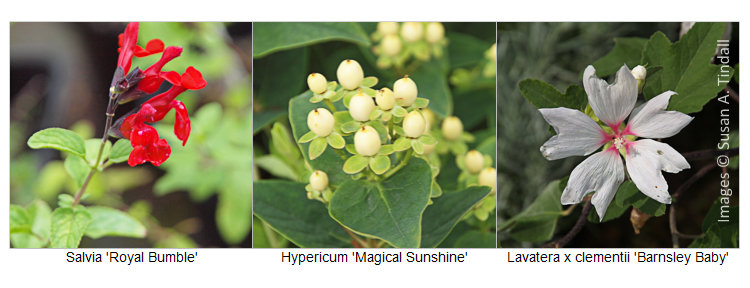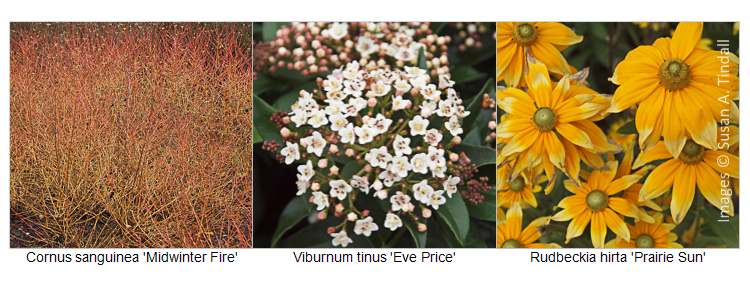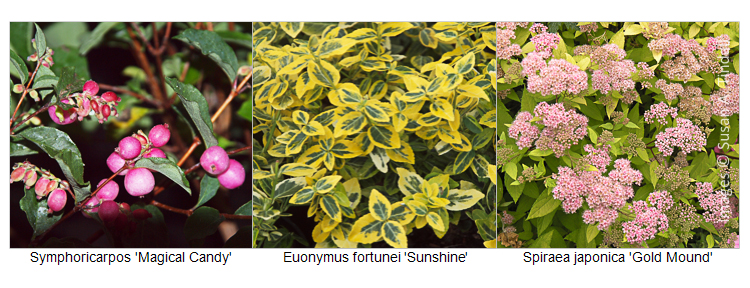Some plants will grow almost anywhere – and not only weeds! In other cases, though, the plant that we have bought may not live up to its promise of lush foliage and plentiful flowers, or in extreme cases could fail completely. The commonest reason is simply that the plant has been put in a place – an environment – which it doesn’t like.
It pays to choose plants for the environments your garden provides.
There are plants for dry, moist and wet places, sunny or shady positions. Some plants require specific soil types e.g. Blueberries need very acidic soil. If you put a plant in the place best suited to its needs it will look happy, perform better, and therefore provide more satisfaction. Fortunately the majority of plants will tolerate a variety of conditions and still give flowers. The following are a few suggestions for easy-going plants that will get you started.
Small variegated shrubs like Euonymus fortunei ‘Sunshine’ are cheery all year through. Grown for its attractive autumn berries Symphoricarpos Magical Candy = ‘Kolmcam’ can also be used as a hedge. Spiraea like sunshine, but tolerate shade and can become a garden staple. Try Spiraea japonica ‘Gold Mound’, with wonderful spring colour and flowers in summer.
Many geraniums provide colour for several months and these include the delicate flowers of Geranium x oxonianum ‘Lace Time’ and showy Geranium sanguineum ‘Vision Light Pink’. Romping vinca for ground cover include Vinca minor f. alba ‘Alba Variegata’. These plants can be divided and moved as you develop your garden and provide excellent value. Finally, consider the lovely aquilegia in their extraordinary variety. These will often set seed – both an asset and a difficulty – they charm in spring with their often exotic flowers and these include Aquilegia Songbird Series.

Soil
Soil can be acidic, neutral or alkaline and a majority of garden plants are tolerant of all three conditions. This is likely to apply to the majority of plants. A few favourites like acid soil – rhododendrons being a prime example. Others will only be happy in alkaline soil; while a number of plants require ‘lime free’ – i.e. neutral or slightly acidic soil. It is possible to grow plants in containers, using rainwater for acid-loving plants, but in general it is easiest to go with the soil chemistry (pH) that you have.
Soil types. The ideal soil is generally considered to be ‘loam’. This is dark, crumbly and rich-looking, providing the ‘well drained but moisture retentive’ conditions preferred by most plants. Soil can range from the light and free draining – sandy or gravelly soils to clay, sometimes heavy clay. In some cases the soil of new builds is imported subsoil that includes pebbles, even rocks and contains very few nutrients. Gravel and sand are gritty when handled, and are low in nutrients but drain freely and are easy to work. Clay is sticky, even silky if moulded in the hand. It is rich in nutrients and holds water, but bakes and cracks in dry summers. It is possible to improve the soil that you have – lightening heavy clay, and enriching poor soils. Many gardeners find that caring for the soil by digging in manure, adding grit to heavy clay, applying mulches, is a satisfying pursuit as they nurture their land. It is possible to change the character of the soil in a very few years.
If this is not for you try the plants that like the soil conditions that you have.
Plants for sand and gravel include Hypericum such as Hypericum x inodorum Magical Sunshine = ‘Kolmasun’ for flowers and fruit. The all summer flowering lavatera such as Lavatera x clementii ‘Barnsley Baby’ as well as the months long flowering season of salvias like Salvia ‘Royal Bumble’.

For clay try bold gold daisies of Rudbeckia like Rudbeckia hirta ‘Prairie Sun’, winter flowering viburnum tinus forms like Viburnum tinus ‘Eve Price’ or for winter colour dogwoods with their colourful stems such as Cornus sanguinea ‘Midwinter Fire’.

The next article will cover light and moisture. Enjoy your gardening.
Joy of Plants

